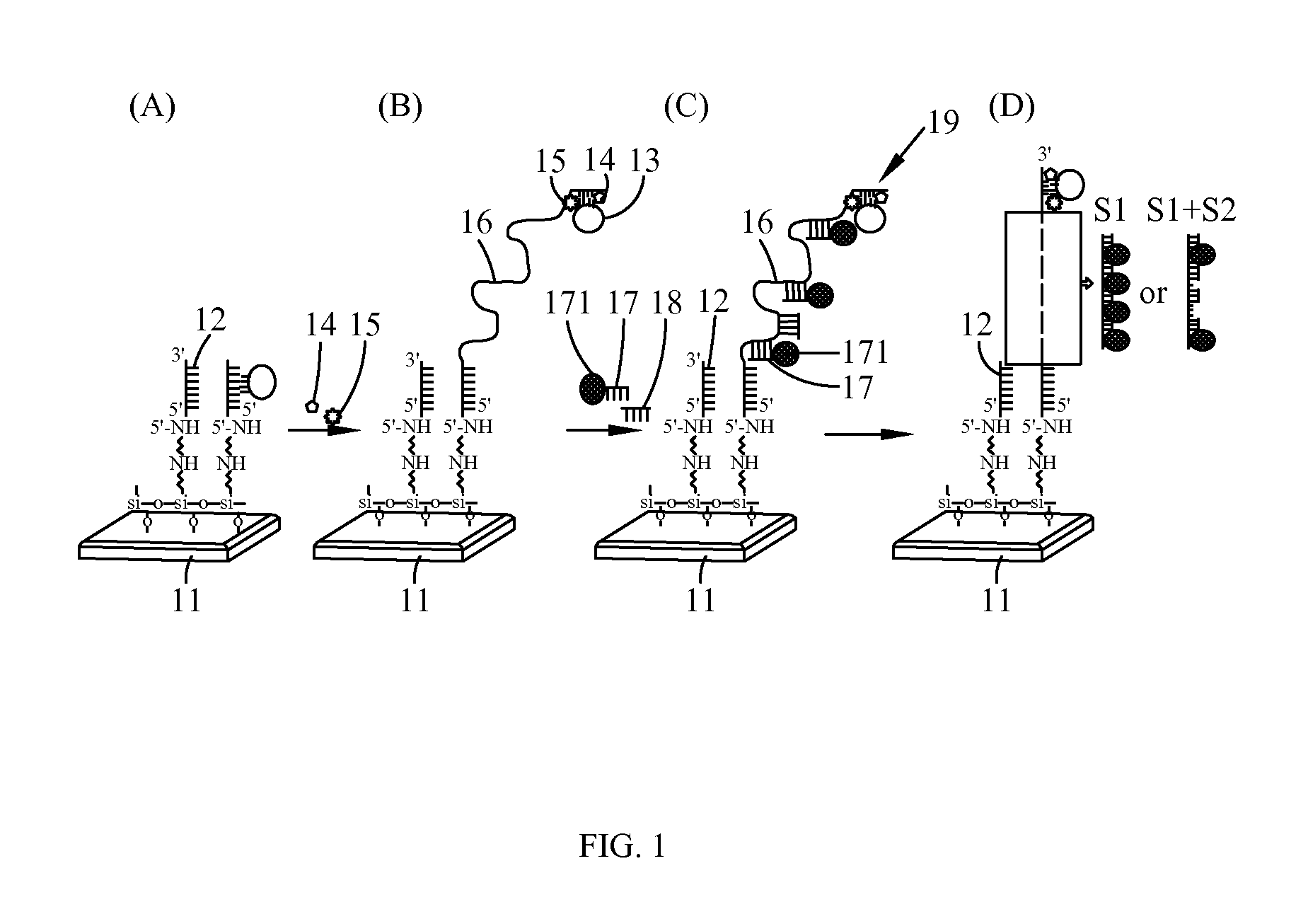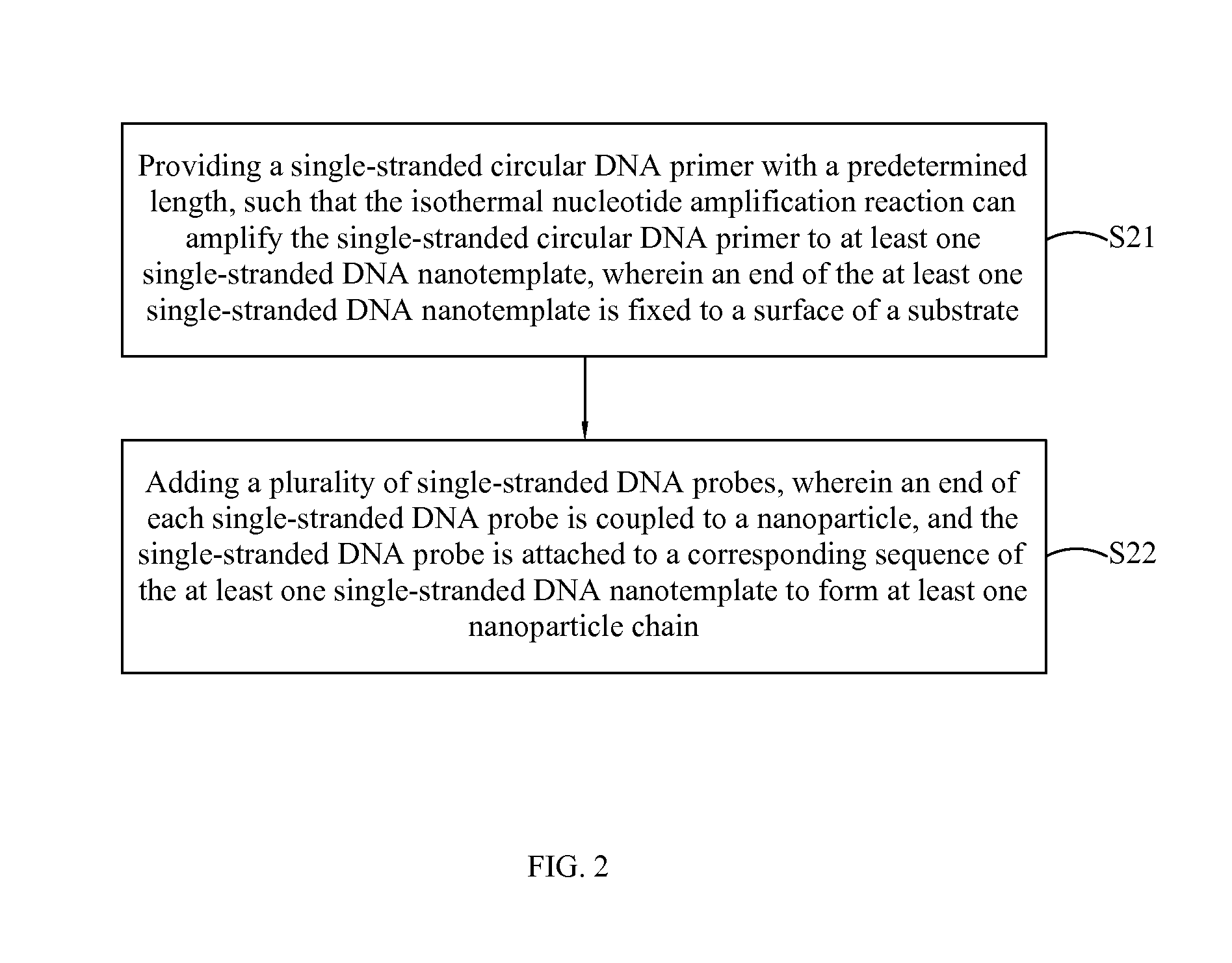Method of manufacturing nanoparticle chain
a nanoparticle chain and manufacturing method technology, applied in the field of nanoparticle chains, can solve the problems of inability to accurately control the alignment of the nanostructure, the inability to install nano devices close next to each other and disposed on the required structure, and the inability to use the bottom-up method to assemble the nanoparticle structure. the effect of increasing the distance between the nanoparticles
- Summary
- Abstract
- Description
- Claims
- Application Information
AI Technical Summary
Benefits of technology
Problems solved by technology
Method used
Image
Examples
embodiment 1
Preparing a Nanoparticle Chain
[0043]The surface of a substrate is modified, and the DNA primer is fixed to the surface of the substrate.
[0044]With reference to FIG. 1 for a schematic view of a method of manufacturing a nanoparticle chain in accordance with an embodiment of the present invention, FIG. 1(A) shows that a self-assembly monolayer (SAM) is formed on the surface of the substrate 11 to serve as a covalent linker, and a DNA primer 12 is fixed to the surface of the substrate 11. In this embodiment, the self-assembly monolayer (SAM) can form the 3-aminopropyl triethoxysilane (APTES) on the surface of the substrate 11 by a silane reaction. At the self-assembly monolayer (SAM) formed on the surface of the substrate 11, the 5′-thiol-labeled DNA primer 12 is added and reacted at 4° C. overnight in order to fix the DNA primer 12 to the surface of the substrate 11. Wherein, the sequence and length of the DNA primer 12 can be designed freely according to requirements, and the DNA pri...
embodiment 2
The Reaction Temperature can be Adjusted to Change the Inter-Nanoparticle Distance of the Nanoparticle Chain
[0054]With reference to FIG. 3 for the flow chart of a method of manufacturing a nanoparticle chain in accordance with an embodiment of the present invention, the method comprises the following steps: S31: Providing at least one single-stranded DNA nanotemplate, wherein an end of at least one single-stranded DNA nanotemplate is fixed to a surface of a substrate, and the at least one single-stranded DNA nanotemplate has a secondary structure; S32: Adding a plurality of first single-stranded DNA probes, wherein an end of each first single-stranded DNA probe is coupled to the nanoparticle, and the single-stranded DNA probe is attached to the corresponding sequence of the at least one single-stranded DNA nanotemplate to form at least one nanoparticle chain having a secondary structure; S33: Adjusting the predetermined reaction temperature to change the secondary structure of at le...
embodiment 3
Preferred Embodiment 3
Single-Stranded DNA Probe Competition
[0057]With reference to FIGS. 1 and 4 for a schematic view and a flow chart of a method of manufacturing a nanoparticle chain in accordance with a preferred embodiment of the present invention respectively, the method as shown in FIG. 4 comprises the following steps. S41: Providing at least one single-stranded DNA nanotemplate, wherein an end of the at least one single-stranded DNA nanotemplate is fixed to a surface of a substrate; and S42: Adding a plurality of first single-stranded DNA probes and a plurality of second single-stranded DNA probes, wherein an end of each first single-stranded DNA probe is coupled to a nanoparticle, a nanoparticle not coupled to the second single-stranded DNA probe, a first single-stranded DNA probe and a second single-stranded DNA probe competitively attached to a corresponding sequence of the at least one single-stranded DNA nanotemplate to form at least one nanoparticle chain.
[0058]More spe...
PUM
| Property | Measurement | Unit |
|---|---|---|
| reaction temperature | aaaaa | aaaaa |
| size | aaaaa | aaaaa |
| particle diameter | aaaaa | aaaaa |
Abstract
Description
Claims
Application Information
 Login to View More
Login to View More - R&D
- Intellectual Property
- Life Sciences
- Materials
- Tech Scout
- Unparalleled Data Quality
- Higher Quality Content
- 60% Fewer Hallucinations
Browse by: Latest US Patents, China's latest patents, Technical Efficacy Thesaurus, Application Domain, Technology Topic, Popular Technical Reports.
© 2025 PatSnap. All rights reserved.Legal|Privacy policy|Modern Slavery Act Transparency Statement|Sitemap|About US| Contact US: help@patsnap.com



